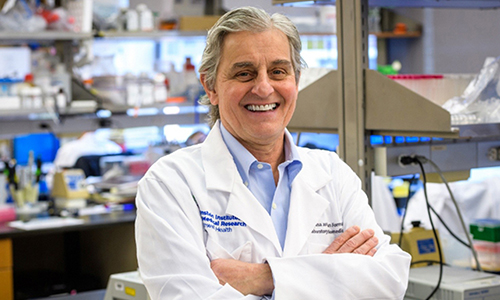Fifteen years ago, Dawn Steiner’s life changed overnight.
Throughout her 43 years, she’d been healthy and active, working as a speech therapist for children with autism and attending head-banging rock concerts and New York Mets games in her leisure time.
But that day, Steiner woke up in so much pain that she could barely get out of bed. She couldn’t even summon the energy to brush her teeth. She waited and hoped for the symptoms to pass, but had a bad feeling that she knew what was happening.
Her family had a history of rheumatoid arthritis (RA), a chronic autoimmune disorder in which the body attacks the tissues lining the joints, resulting in extreme pain and stiffness.
After a few weeks with little improvement, Steiner mustered the strength to visit a rheumatologist, who confirmed her suspicions. The doctor prescribed methotrexate, a standard first-line pharmaceutical treatment intended to slow progression of the disease and reduce inflammation.
And so began Steiner’s 15-year journey fighting RA. Like many patients with the condition, she received injectable medications, which would work for a couple of months before losing their effectiveness. Then her doctor would prescribe a different medication, and the cycle would start again. Some of the treatments worked better for longer. Some of them had debilitating side effects. No matter the intervention, Steiner found herself unable to return to the life she had lived before she developed her disease.
“Lots of times all I could do was work and go to bed,” she says. “There were years I didn’t go to any concerts or Mets games. I thought, ‘I’m going to live the rest of my life this way.’”
Two years ago, just as she was beginning to despair, Steiner noticed a sign at her rheumatologist’s office advertising a clinical trial that was recruiting patients with RA to test a novel therapy: one that involved surgically implanting an electronic device the size of a Tylenol pill in her neck.
Steiner, whose sister survived cancer with the help of a clinical trial, didn’t hesitate to volunteer.
The trial, known as RESET-RA, studied the effectiveness of using electric stimulation of the vagus nerve — a neurological “superhighway” that connects the brain to the rest of the body — to reduce symptoms in people with moderate-to-severe RA. The trial was run by SetPoint Medical, a health technology company, at dozens of locations across the United States, including several academic medical centers.
Kevin J. Tracey, MD, president and CEO of Northwell Health’s Feinstein Institutes for Medical Research, in Manhasset, New York — near Steiner’s home on Long Island — cofounded SetPoint Medical in 2007 to advance the clinical application of vagus nerve stimulation, a field he’s pioneered. He’s helped Northwell launch its first Center for Bioelectronic Medicine, which opened this past spring to connect patients with vagus nerve stimulation clinical trials, such as RESET-RA, and with other Food and Drug Administration (FDA)-approved bioelectronic therapies.
Nearly two years after enrolling in the trial, Steiner is back to attending rock concerts and baseball games. She has an inch-long scar on the left side of her neck where a neurosurgeon implanted the device, which vibrates for one minute every night. The relief she experienced was almost immediate and, so far, has persisted longer than the medications she cycled through for more than a decade, she says.
On July 30, the FDA officially approved the SetPoint Medical device as a treatment for RA, based on the results of the RESET-RA trial.
It’s the latest development in a growing field of scientific and clinical studies focused on enlisting the vagus nerve to help the body heal itself.
Unveiling the vagus nerve’s potential
Though the vagus nerve was first identified nearly 2,000 years ago, scientists began to discover its vital role in modulating the immune system and promoting neuroplasticity — the brain’s ability to build new neural connections — within the past few decades.
Tracey and his colleagues discovered the role of the vagus nerve in inflammation regulation, termed the inflammatory reflex, more than 30 years ago.

Kevin J. Tracey, MD, President and CEO of the Feinstein Institutes for Medical Research at Northwell Health.
Courtesy of the Feinstein Institutes for Medical Research at Northwell Health
Since then, he and his lab — as well as researchers at institutions worldwide — have studied how stimulating the vagus nerve has the potential to treat a wide variety of diseases, including heart disease, inflammatory bowel disease, Parkinson’s disease, Alzheimer’s disease, anxiety and depression disorders, ischemic stroke, diabetes, post-traumatic stress disorder (PTSD), and other diseases linked to inflammation. In 1997, the FDA approved vagus nerve stimulation for epilepsy and treatment-resistant depression.
Other clinical trials have shown promise in patients with PTSD and in those undergoing stroke rehabilitation. The recent FDA decision marks the beginning of a new treatment paradigm using electrical stimulation of the vagus nerve for inflammation-based disorders.
“Most physicians haven’t thought about the vagus nerve since medical school,” says Tracey, whose recent book, The Great Nerve: The New Science of the Vagus Nerve and How to Harness Its Healing Reflexes, encourages patients to educate themselves, as well as their doctors, about the vagus nerve’s power and potential.
Historically, the health care system can be slow to adopt novel approaches to treating disease, and for good reason, Tracey says.
“You don’t want your doctor chasing every shiny object,” he notes. “But at the same time, you don’t want them behind the times. When something is truly innovative, workflows get disrupted. Medicine is the greatest profession in the world, and as it advances, sometimes it can push physicians out of our comfort zone.”
Rest, digest, restore
A regulated immune system works to protect the body from pathogens, and the development of therapies that enhance the immune system response, such as vaccines and immunotherapy for cancer, have saved millions of lives.
But the immune system can overreact, and research has revealed that inflammation — an innate immunological response — plays a role in as much as 80% of all major human diseases.
Researchers have discovered that the vagus nerve — which is actually two nerves, located on either side of the neck, that connect the brain stem to the organs through more than 200,000 fibers — is the main switch that tells the brain how much of an immune reaction is warranted.
In fact, Tracey, who was galvanized after losing a young patient to an immune overreaction while he was a neurosurgery resident in the 1980s, performed a series of experiments in mice that led to his discovery of the role of the vagus nerve in regulating the release of tumor necrosis factor (TNF), a chemical messenger that triggers inflammation.
Essentially, the vagus nerve is the major conduit for the parasympathetic nervous system, which is commonly referred to as the body’s rest-and-digest mode, in contrast with the sympathetic nervous system, which is characterized by fight-or-flight mode. The nerve also operates as a bidirectional communication system, sending signals back and forth between the brain and the rest of the body, and being responsible for maintaining harmony in the body’s systems, including the immune system.
Because the nervous system communicates using electrical impulses, stimulating the vagus nerve with small amounts of electricity can change the way it communicates the immune response — thus acting as a sort of reset button for autoimmune and inflammation-related diseases. And it has the potential to do so without the side effects, costs, and patient-compliance issues associated with pharmaceuticals.
“We’re at an inflection point,” Tracey says. “The next phase of this new therapy is adoption into clinical practice, and that will take a cultural change.”
Neuroplasticity
Vagus nerve stimulation in medicine has also shown the potential to play a role in recovery through a different avenue: neuroplasticity, or the brain’s ability to build new neural pathways.
Researchers at the University of Texas at Dallas’ Texas Biomedical Device Center are studying how combining targeted vagus nerve stimulation, using an implanted device, with rehabilitation and standard therapy can improve recovery from stroke, spinal cord injury, and PTSD.
“The concept we built on came from the question ‘What if you deliver vagus nerve stimulation right after someone moved their arm — can you strengthen the circuits that were damaged by the stroke?’” says Seth Hays, PhD, a biomedical engineer, neuroscientist, and associate professor at UT Dallas. “And ‘If you could strengthen the circuits that are remaining, would that lead to additional recovery?’”
Hays and his colleagues, Michael Kilgard, PhD, a professor in the Department of Neuroscience and director of the Texas Biomedical Device Center, and Robert Rennaker, PhD, who founded the Texas Biomedical Device Center in 2013, have published more than 100 peer-reviewed papers taking this concept from animal models to clinical trials to FDA approval.
The team’s work on rehabilitation from chronic ischemic stroke earned FDA approval in 2021. And in a small clinical trial including nine patients with moderate-to-severe PTSD, none of the participants reported symptoms six months after treatment. Trials are ongoing for various applications of the therapy in rehabilitation.
“With neuroplasticity, it’s about changing — literally rewiring — the brain,” Kilgard says. We’re studying “mostly problems that are circuit imbalances that pills can’t really target.”
They’re still learning the nuances of proper “dosing.”
Rennaker explains that, while most physicians are used to increasing doses of medications to see results, their research finds that, with vagus nerve stimulation, there’s a “Goldilocks zone.” Their studies have found that both too little and too much stimulation can reduce the effectiveness of the intervention.
“The vagus nerve is not magic. You have to activate it in the right way,” Rennaker says.
Still, he is excited to see increasing interest in studying vagus nerve stimulation.
“It’s great seeing the number of innovations starting to come to market that are going away from taking a drug or a pill,” he says. “We’re treating the underlying cause of disease.”
But it is a slow process. Rennaker says that in recent years his team has spent about 70% of its time on paperwork to meet regulatory reporting requirements for the FDA, and he’s had to hire additional staff just to focus on administrative work.
“It’s to keep patients safe, and that’s not a bad thing,” he says. “But things probably could be done to optimize that process.”
It can also be difficult for academic researchers to gain access to proprietary technology, such as vagus nerve stimulation devices. That’s why Rennaker built his own device; it’s designed and manufactured by his biotechnology company, Xnerve Medical. Rennaker hopes to make the device available for other academic researchers to use in their own clinical studies, he says.
“The future is bright,” he adds. “There’s a whole range of new and exciting applications for neuro-modulation, in general.”
The slow march of change
While Tracey sees a hopeful future for vagus nerve stimulation in a broad range of applications, he understands that major shifts in medicine tend to happen slowly.
Currently, the intervention is approved for people with RA after they’ve tried and failed to get relief from standard therapies.
The first person to have a vagus nerve stimulator implanted (to treat severe epilepsy) was in 1988, nine years before the therapy earned FDA approval. And the first person to have the stimulator implanted for RA was in 2011 – a 14 years journey to approval.
Tracey understands the need for the FDA’s process, but believes that physician-scientists like himself, the people in his labs, and those at academic medical centers across the country may need to rethink the pathway from lab bench to bedside.
“As the pace of science and technology accelerates, it’s going to be harder and harder to keep up with advances,” he says. This means researchers will have to look for new funding streams, beyond tenuous federal funding and profit-driven private investment from biomedical companies. And they’ll need to follow the science.
Tracey personally helped to develop the anti-TNF drugs that are now widely used to treat septic shock and inflammatory diseases. The drugs had a market size valued at $24.1 billion in 2024. But as he explains in his book, his research over the past 30 years has led him to believe that vagus nerve stimulation — a therapy that is less expensive and comes with fewer side effects — is the better path forward.
With scientific breakthroughs and advances in technology, Tracey hopes that the health care system becomes more open to innovation.
“We need to realign incentives so that patients have a choice,” he says. “At the end of the day, it’s about the patients.”

